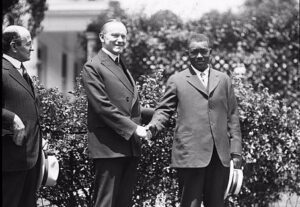
February is Black History Month, and every week we will share information about President Coolidge’s contributions to civil rights and equality during his years in the White House.
On September 24, 2016, America’s first African American president, Barack Obama, presided over the ceremony to inaugurate the National Museum of African American History and Culture on the National Mall in Washington, D.C. This living monument to America’s black heritage was many decades in the making, and in some respects the effort can be traced back to President Calvin Coolidge. On his final day in office, March 4, 1929, President Coolidge signed Public Resolution 107 which initiated a commission to design and construct a national monument to the Negro that would stand as a “tribute to the Negro’s contributions to the achievements of America.”
Unfortunately, the legislation was signed without any funding attached, due to the demands of recalcitrant southern Democrats in Congress. With the onset of the Great Depression during Herbert Hoover’s presidency, the project eventually fizzled out. It was not until the 1960s Civil Rights era that African American lawmakers and leaders reignited the plan. After many years of struggle, President George W. Bush signed the authorizing legislation for the museum in 2003. The National Museum of African American History and Culture now stands as the fulfillment of the initiative President Coolidge launched in 1929.
To learn more, check out our most recent edition of the Coolidge Quarterly. Or come to Plymouth Notch on February 20th at 2:00 pm for a Presidents’ Day talk by Rushad Thomas on Coolidge and Civil Rights. You will not want to miss it!